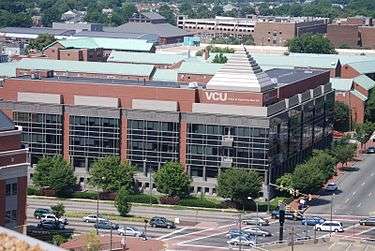VCU School of Engineering
|
VCU Engineering West Hall, Monroe Park campus. | |
| Type | Public university |
|---|---|
| Established | 1996 |
| Dean | Barbara D. Boyan, Ph.D. |
Academic staff | 64 |
| Students | 2,001 (1,714 undergraduate/271 graduate/16 certificate)[1] |
| Undergraduates |
1,505 male (75%) 492 Female (25%) |
| Address |
601 West Main Street Richmond, VA, Richmond, Virginia, USA |
| Campus | Monroe Park Campus |
| Website | http://www.egr.vcu.edu/ |
Establishing a School of Engineering was a major initiative of the first phase of Virginia Commonwealth University's strategic planning process. The initiative was a response to workforce and economic development needs of Richmond and Central Virginia. In 1996, initial courses were offered in mechanical, electrical and chemical engineering. The school added a new undergraduate major in biomedical engineering in the fall of 1998. The undergraduate biomedical engineering program is unique in the commonwealth and responds to the growing presence of biomedical companies in Virginia. VCU's long-standing degree programs in Computer Science joined the School of Engineering in fall 2001. In May 2000, a graduate degree program in engineering was created and added to the historic graduate programs of biomedical engineering.[2]
Facilities
The first two of the School of Engineering's planned facilities opened in the fall of 1998 — the main classroom building and the Virginia Microelectronics Research Center. Together, they total 147,000 square feet (13,700 m2) at a cost of $42 million. To foster growth in enrollment and faculty number, the school embarked on an ambitious campaign to expand facilities, fund endowed scholarships, chairs, and academic programs. The campaign raised more than $67 million to meet these needs.[2]
Current facilities
147,000 square feet (13,700 m2) West Hall [3]
131,000 square feet (12,200 m2) East Hall
28,000 square feet (2,600 m2) Microelectronics Lab
25,000 square feet (2,300 m2) Health & Life Science Engineering Lab
In January 2008, the School opened East Hall, a 120,000-square-foot (11,000 m2) facility housing 48 research labs, 50 faculty offices, six classrooms, and other student spaces allowing for future growth of the School.[2]
Future expansion
According to the recent Masterplan published in February 2013 there are two future buildings planned for expansion of the School of Engineering
- School of Engineering Vivarium — The first expansion will be at the NW corner of Cary St and Belvidere St where the current engineering parking lot exists. The 92,000 square feet (8,500 m2) building is estimated to cost 62.6 million.
- School of Engineering expansion — The second phase will be at the NE corner of Cary St and Belvidere St, south of the School of Business building. The 94,000 square feet (8,700 m2) building is estimated to cost 47 million.[4]
Rankings
VCU Engineering, started in 1996 has seen tremendous growth and completely new facilities. William F. Goodwin, Chairman of the VCU School of Engineering Foundation Board of Trustees, has set an ambitious objective for the engineering program. He's aiming for "25 in 25"- a top 25 engineering-school rank within 25 years.[5] As of 2012, the Biomedical Engineering program is ranked 66th overall while the School of Engineering is ranked 144th.[6]
Departments
- Biomedical Engineering[7]
- Chemical and Life Science Engineering[8]
- Electrical and Computer Engineering[9]
- Computer Science[10]
- Mechanical and Nuclear Engineering[11]
Statistics
Alumni: 2,936 [12]
2010 Freshman Class: 291
2011 Freshman Class: 286
2011 Freshman Admit SAT Mid 50%: 1190 - 1350
2011 Freshman Admit SAT Average: 1280
Fall 2009 Freshmen returning as Sophomores: 80%
Placement after Graduation: 64% full-time employment, 36% Graduate School
Top Employers of Alumni: Mistubishi nuclear energy, Thomas & Betts Power, Altria, MWV, TRANE, and Infilco Degremont.
Student diversity
Undergraduate Fall 2015 Diversity Statistics[1]
White - 944 students (47.2%)
Asian - 377 students (18.8%)
International - 288 students (14.4%)
Black/African American - 188 students (9.4%)
Hispanic/Latino - 113 students (5.6%)
Two or More Races - 59 students (2.9%)
Unknown - 23 students (1.1%)
Native American/Alaskan - 4 students (0.2%)
Hawaiian/Pacific Islander - 2 students (0.1%)
References
- 1 2 "VCU School of Engineering Facts and Figures". VCU School of Engineering. Retrieved 7 June 2016.
- 1 2 3 History - VCU Engineering Archived July 20, 2011, at the Wayback Machine.
- ↑ Created by VCU University Relations (2012-06-19). "Facilities | VCU School of Engineering". Egr.vcu.edu. Retrieved 2013-04-09.
- ↑ http://wp.vcu.edu/vcu2020/files/2013/02/BOVFeb13MPFinal2.pdf
- ↑ Archived December 26, 2009, at the Wayback Machine.
- ↑ http://www.vcu.edu/ranking/
- ↑ Archived October 12, 2011, at the Wayback Machine.
- ↑ Created by VCU University Relations (2012-06-28). "Department of Chemical and Life Science Engineering | VCU School of Engineering". Egr.vcu.edu. Archived from the original on August 29, 2012. Retrieved 2013-04-09.
- ↑ "VCU School of Engineering | Department of Electrical and Computer Engineering". Egr.vcu.edu. 2012-06-18. Archived from the original on April 30, 2012. Retrieved 2013-04-09.
- ↑ "Department of Computer Science | VCU School of Engineering". Egr.vcu.edu. 2012-06-14. Archived from the original on July 29, 2012. Retrieved 2013-04-09.
- ↑ Created by VCU University Relations (2012-06-18). "VCU School of Engineering | Department of Mechanical and Nuclear Engineering". Egr.vcu.edu. Archived from the original on May 29, 2012. Retrieved 2013-04-09.
- ↑ https://web.archive.org/web/20100609111420/http://www.egr.vcu.edu/Page.aspx?id=57. Archived from the original on June 9, 2010. Retrieved September 26, 2011. Missing or empty
|title=(help)
